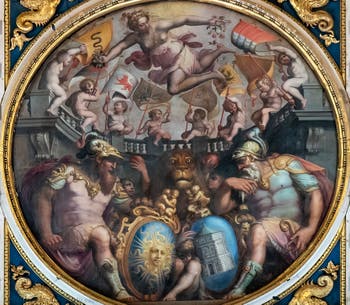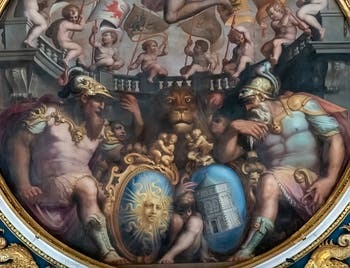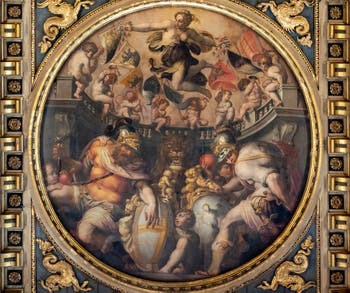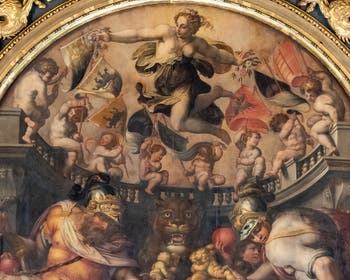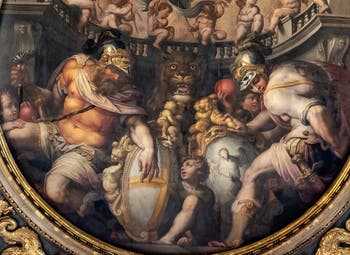Palazzo Vecchio Art Story | Location | Opening Hours Tickets | Authorizations
Art Story Five-Hundred | Tower | Vasari Halls | Dante Mask | Ghirlandaio | Bronzino Sarto Daddi | Salviati | Cortile
Five-Hundred Hall Hall and Ceiling | Ceiling Paintings | Pisa War | Siena War | Sculptures
Ceiling Paintings Cosimo I Medici | Florence History | Wars and Battles | Tuscany
Giorgio Vasari: Florence History on the Ceiling of the Hall of Five Hundred of Palazzo Vecchio in Florence
Giorgio Vasari and Giovanni Stradano, “The Foundation of Florence Roman Colony” on the ceiling of the Hall of Five Hundred of Palazzo Vecchio in Florence, Italy
Painting - Oil on Wood - 1563-1565According to the theory of Poliziano, based on the “Libri Colonarium”, Florence, which was founded in 70 BC, would have become a Roman colony in 43 BC.
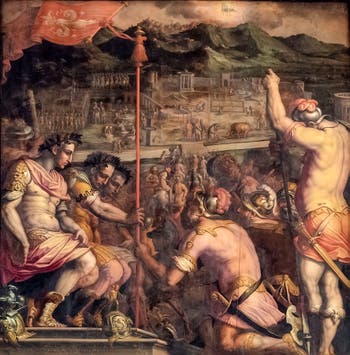
Foundation of Florence Roman Colony This colonization would have occurred during the triumvirate of Octavian Augustus, Marcus Aemilius Lepidus and Mark Antony, who are represented by Vasari on the left of the painting when they give the Florentines the flag of the city with its white lilies on a red background.
The first of the triumvirs represented is Octavian Augustus, recognizable thanks to his helmet topped by an ibex holding a globe and a rudder, its zodiacal sign, but also that of the Duke of Florence Cosimo I de Medici.
In this subtle way, Vasari can symbolically unite the founder of the Roman colony of Florence with Duke Cosimo I, founder of the Tuscan state.
The second triumvir that gives the standard is Mark Antony, recognizable by the Hercules, who overcomes the helmet at his feet.
Finally, the third triumvir is Marcus Aemilius Lepidus, with a horse rearing on the top of his helmet.
Behind the three triumvirs, one can see the ancient city of Florence under construction and that of Fiesole in the distance.
The Florentine colony is built on the banks of the Arno River, and we can see on the left troops in walking order. Many workers are represented in building the first buildings and works of art.
We can see the amphitheatre, the octagonal temple dedicated to Mars, which later became, according to tradition, the baptistery of San Giovanni and the aqueduct.
The fortified walls of the north gate of Florence are already built.
You can also see a man drawing the city's boundaries using a plough pulled by two oxen.
Under the table is written: “FLORENTIA ROM [ANORUM] COLONIA LEGE IULA A III VIRIS DEDUCITUR”.
Giorgio Vasari and Giovanni Stradano, “Arnolfo di Cambio presents the project of expansion of Florence” Ceiling of the Hall of Five Hundred of Palazzo Vecchio in Florence
Painting - Oil on Wood - 1563-1565Vasari represented here the project of the third expansion of the perimeter walls of Florence.
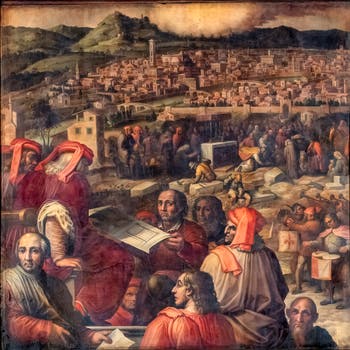
Expansion of Florence This expansion was decided in 1284.
In this painting, we see the architect and artist Arnolfo di Cambio presenting his architectural project to enlarge the city to the members of the Signoria, dressed in antique style.
In the background, we can see the constructions of the Porta San Friano blessed by the bishop kneeling in front of the altar and laying the foundation stone while being surrounded by the managers of the companies responsible for the works.
Work on this third enlargement of the city of Florence ended in 1333, almost half a century later.
At the end of these works, the perimeter of Florence's wall was eight and a half kilometres with large entrance and exit gates of the city and sixty-three guard towers.
Florence was at the time the best walled and organized city in Italy.
Vasari took some liberties with the chronology of the construction of certain Florentine buildings in his painting since the Cathedral of Santa Maria del Fiore was only begun in 1296.
The same applies to the Palazzo Vecchio, built only in 1298 or the bell tower of Giotto, whose works were initiated in 1334.
Under the painting, we read the inscription: "CIVIB [US] OPIB [US] IMPERIO FLORENT [IA] LATIORI POMOERIO CINGITUR".
Giorgio Vasari “Pope Clement IV gives his standard to the captain of the party of the Guelphs” on the ceiling of the Hall of Five Hundred of Palazzo Vecchio in Florence
Painting - Oil on Wood - 1563-1565Vasari represented Pope Clement IV here, giving his standard to the captain and knights of the Guelph Party to extract the Guibellins of Tuscany.
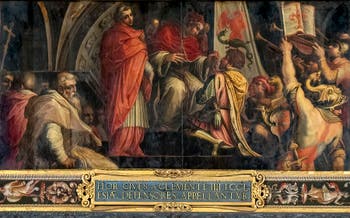
Pope Clement IV Captain Guido Novello is kneeling in front of him and his men to receive the flag of Pope Clement IV with a red eagle grabbing a green dragon.
Arms that were already those of Guy Foulques Le Gros (1249-1268), who became Pope Clement IV in 1265 at the death of Urbain IV.
This pope favoured the Guibellin party that supported the Church.
On the right, one of the knights holds out the standard of Florence with a white lily on a red background.
Under the table we read: “FLOR [ENTINES] CIVES A CLEMENTE IIII ECCLESIAE DEFENSORES APPELLANTUR”.
Giorgio Vasari and Giovanni Stradano, “Union of Florence and Fiesole” Ceiling of the Hall of Five Hundred of Palazzo Vecchio in Florence
Painting - Oil on Wood - 1563-1565According to an unconfirmed tradition, there was a war between Fiesole and Florence in 1010.
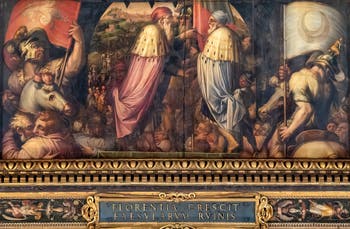
Union of Florence and Fiesole As a result, the town of Fiesole was destroyed mainly, followed by a pacification between Florence and Fiesole and the inhabitants of Fiesole came to live in the north of Florence.
In Vasari's painting, we see the representatives of the two cities shaking hands in front of a man in armour who brings them together.
Vasari also represented the inhabitants of Fiesole who descend from the city's heights loaded with their possessions to settle in Florence.
Two riders each hold the standard of the two cities, the one of Florence on the left with the lily on a red background and Fiesole on the right with the Moon on a white background.
In the foreground, we see the inhabitants of the two cities hugging to celebrate this union.
At the bottom of the table is inscribed: “FLORENTIA CRESCIT FAESULARUM RUINIS”.
Giorgio Vasari, “Allegory of the Districts of Santa Maria Novella and San Giovanni”, Ceiling of the Hall of Five Hundred of Palazzo Vecchio in Florence
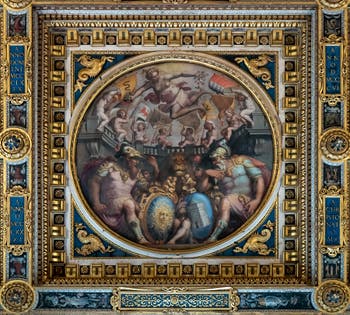
SM Novella and S.Giovanni Painting - Oil on Wood - 1563-1565
The “tondo” (circular painting) of “The Allegory of the Districts of Santa Maria Novella and San Giovanni” painted by Giorgio Vasari on the ceiling of the Hall of Five Hundred of Palazzo Vecchio in Florence shows two armed soldiers representing these two districts of Florence.
On the right is the one that symbolizes the district of San Giovanni, whose baptistery can be seen on an azure background in the coat of arms at his feet.
Just above, the banners of the districts are held by four putti.
There is a golden lion, a green dragon, a pair of keys (barely visible) and in the fourth on the right, the red and azure weapons of the sub-district of Vair.
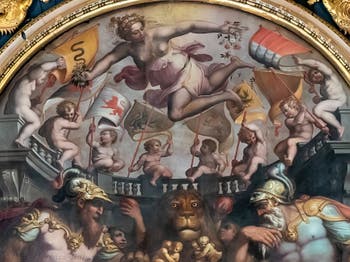
SM Novella and S.Giovanni On the left, there is another helmet soldier with the coat of arms of Santa Maria Novella at his feet, depicting a sun with golden rays on an azure background.
On the banners of the four sub-quarters above, it can be seen from left to right a viper, a unicorn, a red lion and another lion in the latter.
The city of Florence is symbolized by the central lion whose legs are placed on each of the two coats of arms.
The young woman at the top of the painting is Fiorenza, she sows flowers.
Giorgio Vasari, “Allegories of the Districts of Santa Croce and Santo Spirito” Ceiling of the Hall of Five Hundred of Palazzo Vecchio in Florence
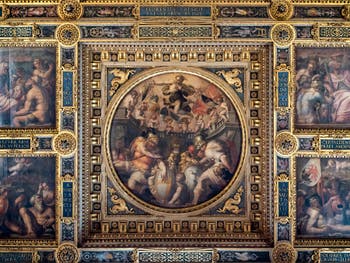
Santa Croce and Santo Spirito Painting - Oil on Wood - 1563-1565
At the bottom of the tondo, the left coat of arms with its golden cross on a pale azure background depicts Santa Croce while the coat of arms on its right is represented as an open mouth from which emerges a dove with a gold aureole.
Above the railing are represented the four banners of each of the two districts.
For Santa Croce, a gold chariot, an ox, a black lion and the wheels.
For Santo Spirito, the ladder, the shell, the globe and the dragon.
The creeping lion, the Marzocco, a symbol of Florence, dominates both coats of arms while a feminine Florence dominates the other symbols.
Giorgio Vasari and Jacopo Zucchi, “Allegory of Certaldo of the district of Santo Spirito” Ceiling of the Hall of Five Hundred of Palazzo Vecchio in Florence
Painting - Oil on Wood - 1563-1565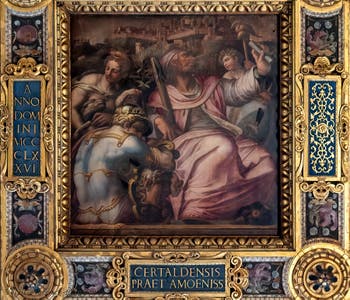
Allegory of Certaldo Certaldo is a vicariate in the Santo Spirito district of Florence.
Vasari represented a judge holding a roll of documents, laws and legal acts.
It is accompanied by Minerva, sitting from the back in the foreground, which holds an olive branch.
On the coat of arms held by Minerva, one can see a face with an open mouth.
It symbolizes eloquence.
This region of Certaldo is indeed the homeland of the father of Tuscan eloquence, Giovanni Boccaccio.
Vasari also painted a pastoral nymph that holds a lamb to emphasize the country beauty of this part of Florence.
On the right, a putto holds a Certaldo coat of arms with an onion depicted in front of a field.
Under the allegory, we read: “CERTALDENSIS PRAET [URA] AMOENISS [IMA]”.
Ceiling Paintings Cosimo I Medici | Florence History | Wars and Battles | Tuscany
Five-Hundred Hall Hall and Ceiling | Ceiling Paintings | Pisa War | Siena War | Sculptures
Art Story Five-Hundred | Tower | Vasari Halls | Dante Mask | Ghirlandaio | Bronzino Sarto Daddi | Salviati | Cortile
Palazzo Vecchio Art Story | Location | Opening Hours Tickets | Authorizations
Back to Top of Page


